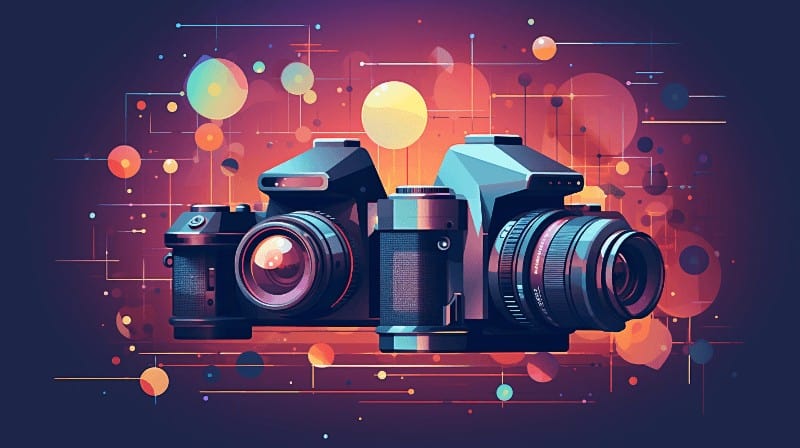In this article, we analyzed hundreds of images from a leading global astrophotography competition to investigate Full Frame vs APS-C Astrophotography.
Most DSLR and mirrorless cameras these days have either full-frame or APS-C (crop) sensors. But what is the difference and what is best for photographing the night sky and astronomical objects?
We found that full-frame cameras are overwhelmingly more successful and are especially suited for landscape and Milky Way astrophotography.
However, APS-C sensor cameras do have their advantages and can be better for deep sky and planetary astrophotography.
Read on for more analysis and to find out why this is the case
Full Frame vs Crop Sensor Astrophotography
We analyzed 376 images shortlisted for the Astronomy Photographer of the Year competition for the past three years (2019-2021) to see what camera sensor sizes were being used.
Of these 376 images, 205 were taken with DSLR or mirrorless cameras and that forms the basis of our results here:
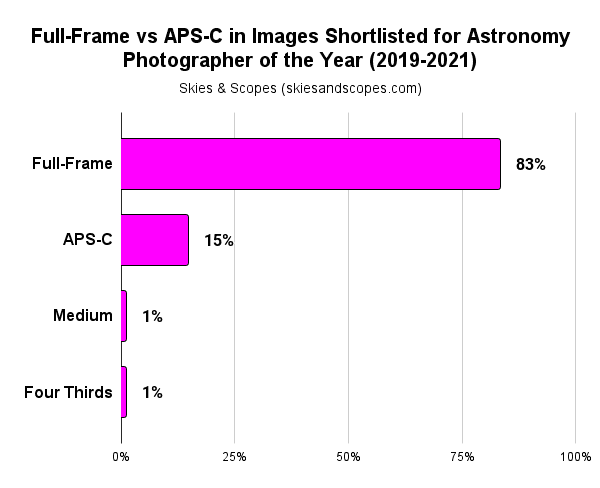
As you can see from the chart in the introduction above, the vast majority of these astrophotography images have been taken with full-frame cameras.
If you want to see which camera models have been most successfully used, see the Best Cameras for Astrophotography.
We can now also split this data between landscape astrophotography images, and planetary and deep sky images since these are two fairly distinct different types of astrophotography.
Full Frame vs APS-C for Landscape Astrophotography
Firstly, with just landscape astrophotography we see that it is even more likely that full-frame cameras were used:
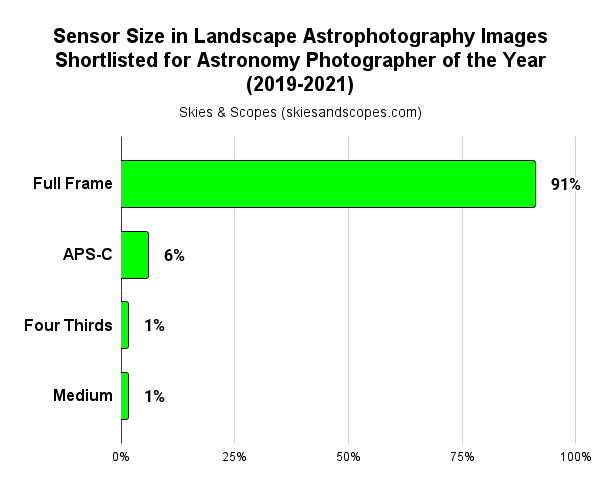
This is because full-frame sensor cameras allow the photographer to capture a wider expanse of the sky.
This is particularly important for landscape astrophotography where you are usually trying to capture the Milky Way or a wide expanse of the starry sky above a landscape on the ground.
What APS-C sensors do is crop this image so that a narrower expanse of the sky is in the frame.
For example here, you can see for illustrative purposes how much sky would be captured with a full-frame Canon EOS 5D Mark IV and an APS-C Canon EOS 1000D:
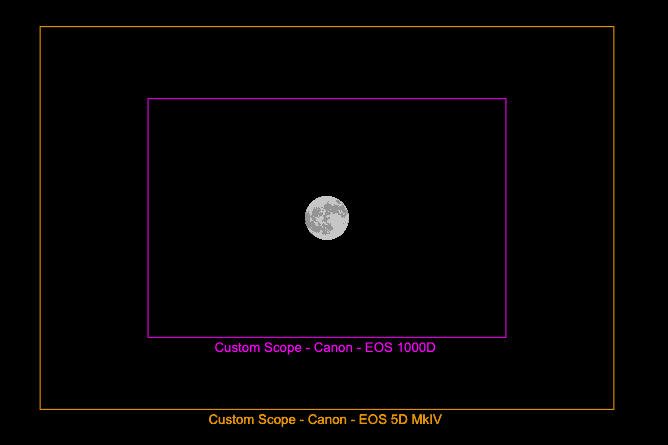
You can see that the full-frame camera captures a larger space of the night sky.
Full Frame vs APS-C for Deep Sky and Planetary Astrophotography
However, in contrast to landscape astrophotography, for planetary and deep-sky photography a cropped image may be what you want since it allows you to get closer to the specific object that you are targeting.
Therefore is an APS-C camera better for planetary and deep-sky astrophotography?
You can see here the results when we look at just deep-sky and planetary images:
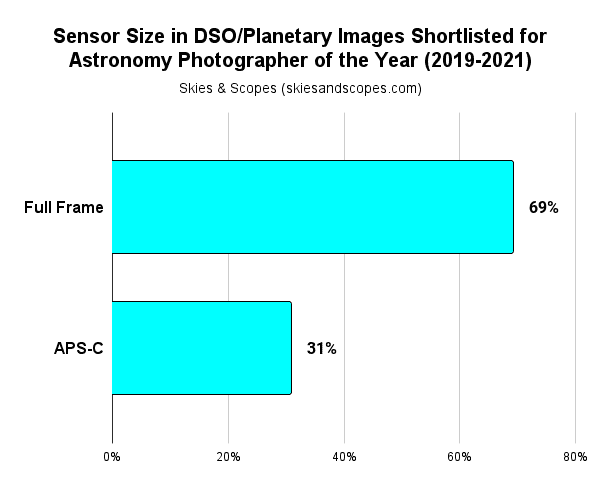
As you can see, a much higher percentage is taken with APS-C sensor cameras, although the majority are still with full frame cameras.
Full Frame Camera Advantages for Astrophotography
The reasons full frame sensor cameras are better for landscape astrophotography are:
- the lenses designed for full frame cameras guide more light onto the sensor
- having a bigger sensor means that the pixels are more spread out and this reduces noise in images
- having a bigger sensor means that the pixels can be bigger and wider, meaning that they are better at capturing light
This third point is also why having a higher megapixel number is not always best for astrophotography, since cramming more pixels onto the same sensor just means that the pixels are smaller and therefore less efficient at capturing light and have worse thermal performance and more noise.
The only real downside of full frame cameras is that they cost substantially more. A modern full frame camera will cost at least $1000, and can go up to $4000 or even more.
APC-S Camera Advantages for Astrophotography
The advantages of APS-C sensor cameras for astrophotography are:
- They can allow you to compose images with a narrower field of view and this means you can zoom in closer to targets like planets, or deep sky objects
- They are substantially cheaper. You can get a top APS-C camera from a leading brand like Canon or Nikon for around $500.
FAQs: Astrophotography Sensor Size
Are full frame cameras good for astrophotography?
Full frame cameras are best for astrophotography since they allow pixels to be larger and more spread out on the sensor. This improves performance in light gathering and reduces noise.
In addition, they are best for landscape astrophotography using where you generally want to capture a wide expanse of starry sky above a landscape using a wide-angle lens.
Are APS-C crop sensor cameras good for astrophotography?
APS-C (crop) sensor cameras are more limited for astrophotography because they are not as good at light gathering in low light conditions than full frame cameras.
However, they do allow a narrower field of view which can be an advantage for planetary or deep sky imaging, and APS-C cameras are cheaper.
Is a bigger sensor better for astrophotography?
A bigger sensor, like that in a full frame camera, allows the pixels to be larger and more spread out which improves light capture and noise performance.
What kind of camera is best for astrophotography?
A full frame DSLR or mirrorless camera is best for astrophotography.
See the Best Cameras for Astrophotography or Best Mirrorless Cameras for Astrophotography for recommended models.
See also DSLR vs Mirrorless Cameras for Astrophotography if you want to dig into that.
Can you use any DSLR camera for astrophotography?
Yes, you can use any DSLR camera for astrophotography. If you already have an entry-level APS-C crop sensor camera then you should give it a go with that first.
If you want to upgrade later, go for a full frame camera.
How many megapixels do you need for astrophotography?
There is a balance between higher megapixels giving you more image detail but reducing the performance of the camera in low light. The top cameras for astrophotography tend to have around 20-30MP.
See our article, How Many Megapixels Do You Need For Astrophotography?, for more on this.
Can you use a full frame lens on crop sensor camera?
Full frame lenses should always work on crop sensor cameras. The image will just be cropped narrower.
This means that, for example, using a 14mm lens on a full frame camera gives you 14mm width, but a 14mm lens on a crop sensor camera will effectively perform as a 21mm lens.
Can you use a crop sensor lens on full frame camera?
Crop sensor lenses will work on full-frame cameras but the images will likely have black vignetting around the edges and corners.
This is because the lens is designed to project a smaller image than the full-frame sensor is designed to capture.
In addition, some crop sensor lenses may not mount on full frame cameras for compatibility reasons.
Verdict: Full Frame vs APS-C Astrophotography
Overall, it is clear that full-frame cameras are generally better for astrophotography, especially landscape astrophotography.
Ideally, you get a full frame model with around 20-30 megapixels for optimum performance in low light.
See the Best Cameras for Astrophotography for recommended models.
Please let us know if you have any questions or comments below.


